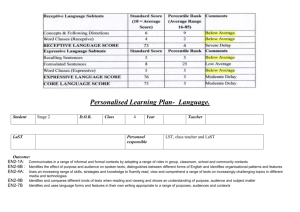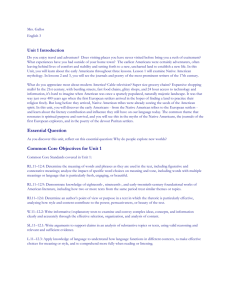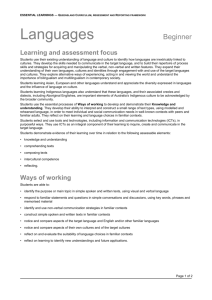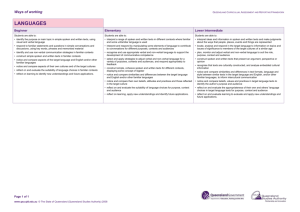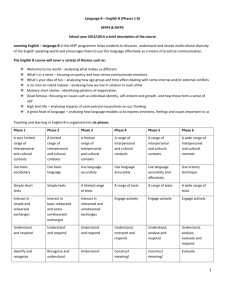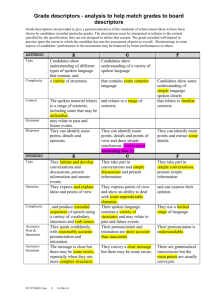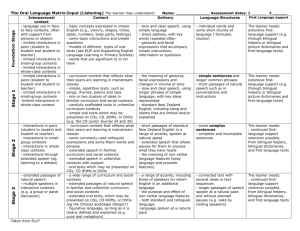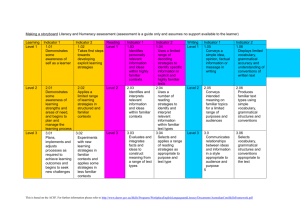APP Speaking and listening: Assessment Focuses and Criteria
advertisement
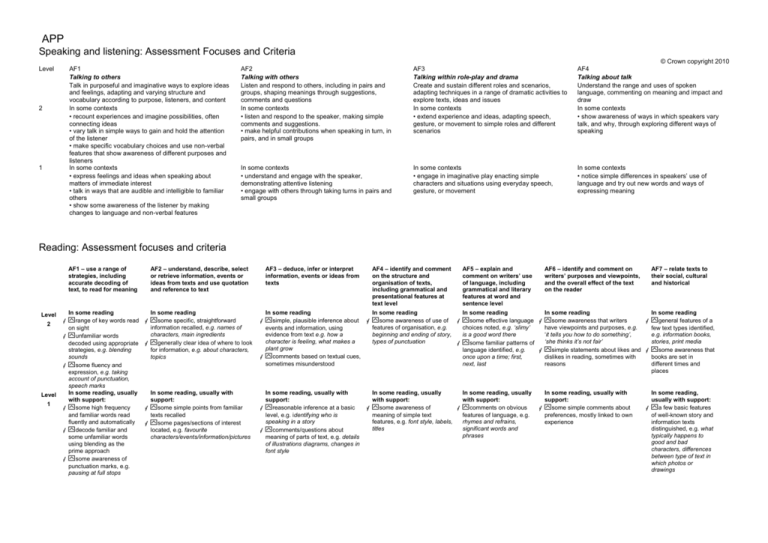
APP Speaking and listening: Assessment Focuses and Criteria Level AF1 Talking to others Talk in purposeful and imaginative ways to explore ideas and feelings, adapting and varying structure and vocabulary according to purpose, listeners, and content In some contexts • recount experiences and imagine possibilities, often connecting ideas • vary talk in simple ways to gain and hold the attention of the listener • make specific vocabulary choices and use non-verbal features that show awareness of different purposes and listeners In some contexts • express feelings and ideas when speaking about matters of immediate interest • talk in ways that are audible and intelligible to familiar others • show some awareness of the listener by making changes to language and non-verbal features 2 1 AF2 Talking with others Listen and respond to others, including in pairs and groups, shaping meanings through suggestions, comments and questions In some contexts • listen and respond to the speaker, making simple comments and suggestions. • make helpful contributions when speaking in turn, in pairs, and in small groups AF3 Talking within role-play and drama Create and sustain different roles and scenarios, adapting techniques in a range of dramatic activities to explore texts, ideas and issues In some contexts • extend experience and ideas, adapting speech, gesture, or movement to simple roles and different scenarios © Crown copyright 2010 AF4 Talking about talk Understand the range and uses of spoken language, commenting on meaning and impact and draw In some contexts • show awareness of ways in which speakers vary talk, and why, through exploring different ways of speaking In some contexts • understand and engage with the speaker, demonstrating attentive listening • engage with others through taking turns in pairs and small groups In some contexts • engage in imaginative play enacting simple characters and situations using everyday speech, gesture, or movement In some contexts • notice simple differences in speakers’ use of language and try out new words and ways of expressing meaning Reading: Assessment focuses and criteria Level 2 AF1 – use a range of strategies, including accurate decoding of text, to read for meaning AF2 – understand, describe, select or retrieve information, events or ideas from texts and use quotation and reference to text In some reading In some reading y range of key words read y some specific, straightforward on sight y unfamiliar words y Level 1 y y y decoded using appropriate strategies, e.g. blending sounds some fluency and expression, e.g. taking account of punctuation, speech marks In some reading, usually with support: some high frequency and familiar words read fluently and automatically decode familiar and some unfamiliar words using blending as the prime approach some awareness of punctuation marks, e.g. pausing at full stops y y y information recalled, e.g. names of characters, main ingredients generally clear idea of where to look for information, e.g. about characters, topics In some reading, usually with support: some simple points from familiar texts recalled some pages/sections of interest located, e.g. favourite characters/events/information/pictures AF3 – deduce, infer or interpret information, events or ideas from texts AF4 – identify and comment on the structure and organisation of texts, including grammatical and presentational features at text level In some reading In some reading y simple, plausible inference about y some awareness of use of y y y events and information, using evidence from text e.g. how a character is feeling, what makes a plant grow comments based on textual cues, sometimes misunderstood features of organisation, e.g. beginning and ending of story, types of punctuation In some reading, usually with support: reasonable inference at a basic level, e.g. identifying who is speaking in a story comments/questions about meaning of parts of text, e.g. details of illustrations diagrams, changes in font style In some reading, usually with support: some awareness of meaning of simple text features, e.g. font style, labels, titles y AF5 – explain and comment on writers’ use of language, including grammatical and literary features at word and sentence level AF6 – identify and comment on writers’ purposes and viewpoints, and the overall effect of the text on the reader In some reading In some reading y some effective language y some awareness that writers y y choices noted, e.g. ‘slimy’ is a good word there some familiar patterns of language identified, e.g. once upon a time; first, next, last In some reading, usually with support: comments on obvious features of language, e.g. rhymes and refrains, significant words and phrases y y have viewpoints and purposes, e.g. ‘it tells you how to do something’, ‘she thinks it’s not fair’ simple statements about likes and dislikes in reading, sometimes with reasons In some reading, usually with support: some simple comments about preferences, mostly linked to own experience AF7 – relate texts to their social, cultural and historical In some reading y general features of a y y few text types identified, e.g. information books, stories, print media some awareness that books are set in different times and places In some reading, usually with support: a few basic features of well-known story and information texts distinguished, e.g. what typically happens to good and bad characters, differences between type of text in which photos or drawings

